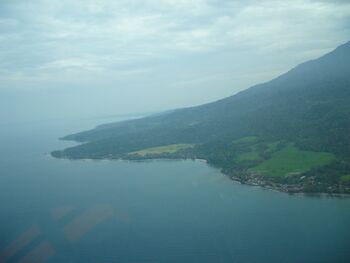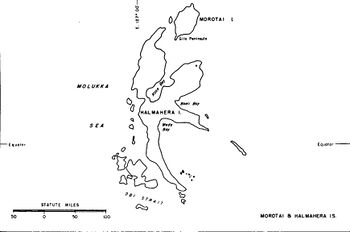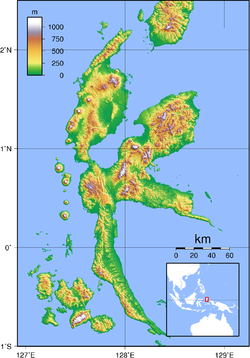هالماهيرا
 Coastline of Halmahera | |
 Small scale map of the island | |
| الجغرافيا | |
|---|---|
| الموقع | South East Asia |
| الإحداثيات | 0°36′N 127°52′E / 0.600°N 127.867°E |
| الأرخبيل | Maluku Islands |
| المساحة | 17,780 km2 (6,860 sq mi) |
| ترتيب المساحة | 51st |
| أعلى منسوب | 1٬560 m (5٬120 ft) |
| أعلى نقطة | Mount Gamkonora |
| الإدارة | |
| Province | قالب:Country data North Maluku |
| Largest settlement | Tobelo |
| السكان | |
| التعداد | 449,938 (2010) |
| الكثافة السكانية | 25٫3 /km2 (65٫5 /sq mi) |
| الجماعات العرقية | Tobelo, Bugis, Togutil, Galela, Sahu, Waioli, Modole, Pagu, Kao Islam, Sawai, Gane, Buli, Maba, Loloda, Tabaru, Patani, Bicoli. Significant migrant groups include Sangir, Ternate, Tidore, Makian, and Javanese. |
هالماهيرا (جيلولو أو گيلولو) هي أكبر جزيرة بين جزر مالوكو. وهي جزء من مقاطعة مالوكو الشمالية لـ إندونيسيا.
تبلغ مساحة هالماهيرا 17.780 كيلو متر مربع (6865 ميل مربع) وفي عام 1995 بلغ عدد سكانها162.728. ما يقرب من نصف سكان هالماهيرا من المسلمين ، ونحو النصف من المسيحيين.
التاريخ
Sparsely-populated Halmahera's fortunes have long been closely tied to those of the smaller islands of Ternate and Tidore, both off its west coast. This island was the site of Sultanate of Jailolo, one of the four kingdoms of Maluku (Maloko Kië Raha, of Ternate, Tidore, Bacan, and Jailolo) in the era before Dutch East India Company colonized the entire archipelago. The north of the island is also the base of Loloda Kingdom, one of the earlier 13th century Moluccan kingdom, but not recognized as one of the prominent four.[1]
During World War II, Halmahera was the site of a Japanese naval base at Kao Bay.
In 1999 and 2000, Halmahera was the site of violence that began as a purely ethnic dispute between residents of (mainly Christian) Kao and (entirely Muslim) Malifut sub-districts and then took on a religious nature as it spread through much of the North Moluccas, called the Maluku sectarian conflict. Thousands of people on Halmahera were killed in the fighting between religious militias. In June 2000, about five hundred people were killed when a ferry carrying refugees from the fighting on Halmahera sank off the northeast tip of Sulawesi island. Conspiracy theories about this event abound. A memorial to this tragedy can be found in Duma village in North Halmahera district.
Today, much transportation to the rest of Indonesia is through connections on the provincial capital, Ternate island although Tobelo, the largest town on Halmahera, also has direct ferry and cargo sea links to Surabaya and Manado.[بحاجة لمصدر]
Particularly, since the inauguration of the first ever directly elected Bupati (Regent or District Head), Tobelo is undergoing rapid development and is aiming at rivaling Ternate's historical dominance.[بحاجة لمصدر] As it is surrounded by flat land, Tobelo has the potential for expansion.[بحاجة لمصدر] Ternate is limited by its size, being a small island which can be driven around in forty-five minutes. Also, in 2010, the provincial government has moved the provincial capital from Ternate City to Sofifi, a small village on the Halmahera coast opposite Tidore island.
North Maluku Province consists of eight regencies and two municipalities (cities); five of the regencies and one municipality include a part of Halmahera island. The regencies are North Halmahera, West Halmahera, East Halmahera, Central Halmahera, South Halmahera, Morotai, Sula Islands and Taliabu, while the municipalities are Ternate and Tidore Islands. Only Ternate Municipality, and Morotai, the Sula Islands and Taliabu regencies do not include any part of Halmahera.
The coastal area of Halmahera inhabited by the Tobelo people (or the O’Hoberera Manyawa (literally "people that live outside of the forest")),[2] while a small semi-nomadic related population living on the inner parts of Halmahera, the number of Togutil people (or the O'Hongana Manyawa (literally "people that live inside of the forest")) is estimated between 1500 and 3000 people (according to studies of ethnologists since 2001).[3]'[4] From 300 to 500, (also an estimatation), live in isolation in the forest in the Aketajawe-Lolobata National Park where they obtain their means of subsistence.[5] Uncontacted members are being threatened by a massive Indonesian mining project to produce nickel for electric car batteries.[6]
الجيولوجيا
The volcanic island lies on an island arc that includes the Raja Ampat Islands, all uplifted by the northward migration of the continent of Australia and subduction of the Pacific Plate. Dukono is an active volcano at the north end of the island. Mount Ibu is an active volcano on the island's northwest coast.
البيئة
The flightless invisible rail is endemic to the island.[7] The recently discovered palm tree Jailoloa halmaherensis is also endemic to Halmahera.[8]
The naturalist Alfred Russel Wallace visited Halmahera, as described in his 1869 book The Malay Archipelago. He considered the standardwing bird of paradise, Semioptera wallacii, to be his greatest prize.[9] It was in February 1858, on the island of Ternate (or perhaps while on Halmahera itself), between bouts of fever, that Wallace came to the idea of natural selection via the survival of the fittest. Wallace wrote his ideas during the next couple of days, and sent the historical letter to Darwin.
التعدين في هالماهيرا
Halmahera is the site of several mining projects.
PT Weda Bay Nickel operates a nickel and cobalt mining project in North and Central Halmahera Regencies, the Weda Bay Industrial Park. It is one of the world's largest nickel mining operations.[10] The Indonesian government has prohibited the export of unprocessed nickel ore since 2022.[11] As a result, the ore must first be processed on the island before being exported. A total of 11 (with three more in construction) power plants have already been built for this process. The park is likely to get even bigger. Several investors have already been found willing to invest.[12] The increased demand for nickel for batteries is one of the reasons for the growth.
معرض صور
المصادر
- ^ Handoko, Wuri (2017). "Kerajaan Loloda: Melacak Jejak Arkeologi Dan Sejarah". Kapata Arkeologi (in الإندونيسية). 13 (2): 179–194. doi:10.24832/kapata.v13i2.423. ISSN 2503-0876.
- ^ "Mengenal O'Hongana Manyawa di Hutan Halmahera yang 'Dikepung' Tambang Nikel". ppman (in الإندونيسية). 2024-03-23. Retrieved 2024-06-12.
- ^ Tamalene, M. Nasir (January 2014). "The Practice of Local Wisdom of Tobelo Dal a m ( Togutil ) Tribal Community in Forest Conservation in Halmahera, Indonesia".
- ^ https://www.academia.edu/1933038/Duncan_Christopher_R_2001_S avage_Imagery_Mis_Representations_of_the_Forest_Tobelo_of_Indonesia_The_Asia_Pacific_Journal_of_Anthropology_2_1_45_62
- ^ https://www.academia.edu/34706882/LOCAL_KNOWLEDGE_OF_MANAGEMENT_SYSTEM_OF_FOREST_ECOSYSTEM_BY_TOGUTIL_ETHNIC_GROUP_ON_HALMAHERA_ISLAND_INDONESIA_ TRADITIONAL_UTILIZATION_AND_CONSERVATION
- ^ "NEWS: Indonesia: Uncontacted tribe being destroyed for electric car batteries". Survival International. 4 April 2023. Archived from the original on 6 April 2023. Retrieved 6 April 2023.
- ^ BirdLife International (2016). "Habroptila wallacii". IUCN Red List of Threatened Species. 2016: e.T22692781A93369321. doi:10.2305/IUCN.UK.2016-3.RLTS.T22692781A93369321.en. Retrieved 11 November 2021.
- ^ Heatubun, Charlie D.; Zona, Scott; Baker, William J. (2014). "Three new genera of arecoid palm (Arecaceae) from eastern Malesia". Kew Bulletin. 69 (3): 9525. Bibcode:2014KewBu..69.9525H. doi:10.1007/s12225-014-9525-x. S2CID 24848021.
- ^ "Halmahera and Wallace's Greatest Prize: The Standardwing Bird of Paradise". Wallace Fund. Archived from the original on 24 September 2018. Retrieved 1 April 2015.
- ^ "Ej Atlas". ejatlas.org. Retrieved 2024-12-20.
- ^ "Prohibition of the export of nickel ore – Policies". IEA (in الإنجليزية البريطانية). Retrieved 2024-12-20.
- ^ Indonesian island fights to curb impact of toxic nickel mine – DW – 07/06/2024 (in الإنجليزية). Retrieved 2024-12-20 – via www.dw.com.
وصلات خارجية
 Media related to Halmahera at Wikimedia Commons
Media related to Halmahera at Wikimedia Commons- Halmahera history
- Pages using gadget WikiMiniAtlas
- CS1 الإندونيسية-language sources (id)
- CS1 الإنجليزية البريطانية-language sources (en-gb)
- Short description is different from Wikidata
- Coordinates on Wikidata
- Articles with unsourced statements from December 2010
- Articles with unsourced statements from April 2015
- Articles with hatnote templates targeting a nonexistent page
- مناطق ايكولوجية
- شمال مالوكو
- هالماهيرا
- جزر الملوك





